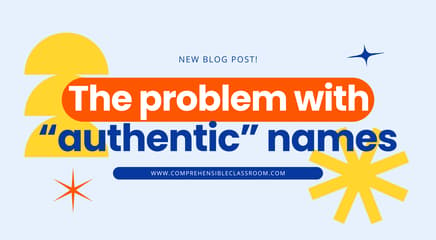For the first time since learning about TPRS® and Comprehensible Input, I am not teaching through CI, but learning through CI. I've of course participated as a student in demonstrations and coaching sessions in languages that I don't know, but I've never "studied" a language for an extended period of time. (I say "studied" with quotation marks because I am not studying a language at all--just "coming to know".)
I am now very excited to announce that I know (some) French! I am becoming trilingual!! What an exciting thing. This has been an absolute blast for me, partly because IT IS SO MUCH FUN TO LEARN A LANGUAGE, and partly because I have had many insights into what it is like to be one of my students--which is the purpose of this post.
How am I learning French?
I began learning French by reading the novel "Brandon Brown veut un chien" by Carol Gaab. I was able to do this without any vocabulary instruction or translation because I am already very familiar with the Spanish version of the novel. Between my knowledge of the plot and the similarities between French and Spanish, I can easily figure out any new words that I encounter in the novel. I have been doing some work with the Teacher's Guide for the novel, and I do the quizzes from the guide after I read each chapter. Now that I've finished reading the novel and working with all of the quizzes, I am listening to the audio version of the novel. Meanwhile, I've been formatting the French adaptations of my Spanish curriculum, put together by Julia Ullman and edited by Karen Oberlander, so I am getting in more comprehensible input by reading Julia's translations and listening to the authentic resources that she has included in the adapted units.
Other than French, what have I learned?
- Comprehensible Input works. I am learning French by reading and listening to contextualized language. The only rules that I have learned have come to me from Karen or from Megan Murphy (who has translated some of my activity forms into French) when they send me corrections on my French writing. I have now written several short, original texts in French--and one of them had ZERO errors. This is because...
- Learning high frequency structures leads to communicative competency. Brandon Brown veut un chien is written with the highest-frequency structures in the French language, and so are the curriculum units that Julia has translated for me. Because the first words that I learned were words such as "wants", "has", "says", "goes", "sees", etc., I can speak and write on a myriad of topics already (effectively albeit simply), even though my vocabulary is very, very, VERY small.
- Listening and reading are both important. As I said, the first thing that I did to learn French was read. I was able to visualize the content as I was reading, but I was not able to hear the words in my head. This was actually a pretty big stumbling block for my comprehension! Not being able to hear the words in my head was very distracting for me, and it severely impeded my fluency (the rate at which I was reading) and retention. Once I began listening to the audio version of the novel, I could read the novel faster, and output (both written and oral) became easier for me.
- Speaking is scary.My in-laws are in town, and both my husband and my father-in-law took French in high school. I keep getting excited about my ability to speak French and begin saying something, but when I realize that I don't sound anything like a native French speaker, I get embarrassed and stop talking. When I come to a block and can't think of how I could say what I want to say, I get embarrassed and stop talking. Writing is much easier. I have the time to think about what I want to say and how else I could say it, and my errors do not embarrass me. I am reminded why I do not give speaking assessments until at least the second quarter of Spanish 1; only after students have had many opportunities to practice speaking during low-anxiety, communicative activities.
- Limited grammar instruction is helpful after receiving input. Pop-up grammar is an essential component of quality TPRS®/CI instruction, and it works! When I send my writing to Karen, Megan, or Julia, they give me quick explanations for each of their corrections. These quick explanations made sense to me because they were contextualized and to-the-point. I was able to read their correction and then look back at all of the things that I've read and say, "Oh yeah! That makes sense! Now, I understand what that letter means on the end of a word!"
If you would like to learn a new language or if you'd like to try teaching a novel, be sure to click here and leave a comment on my 500th post for a chance to win one of three TPRS Publishing Teacher Packages. You can also visit my STORE page and make a shopping list for the Cyber Savings sale on TpT: save 20 percent on any lesson plans and activities that you purchase from my TpT store on Monday and Tuesday.





